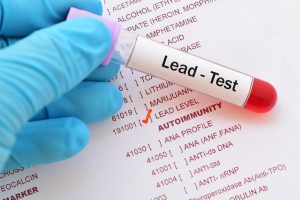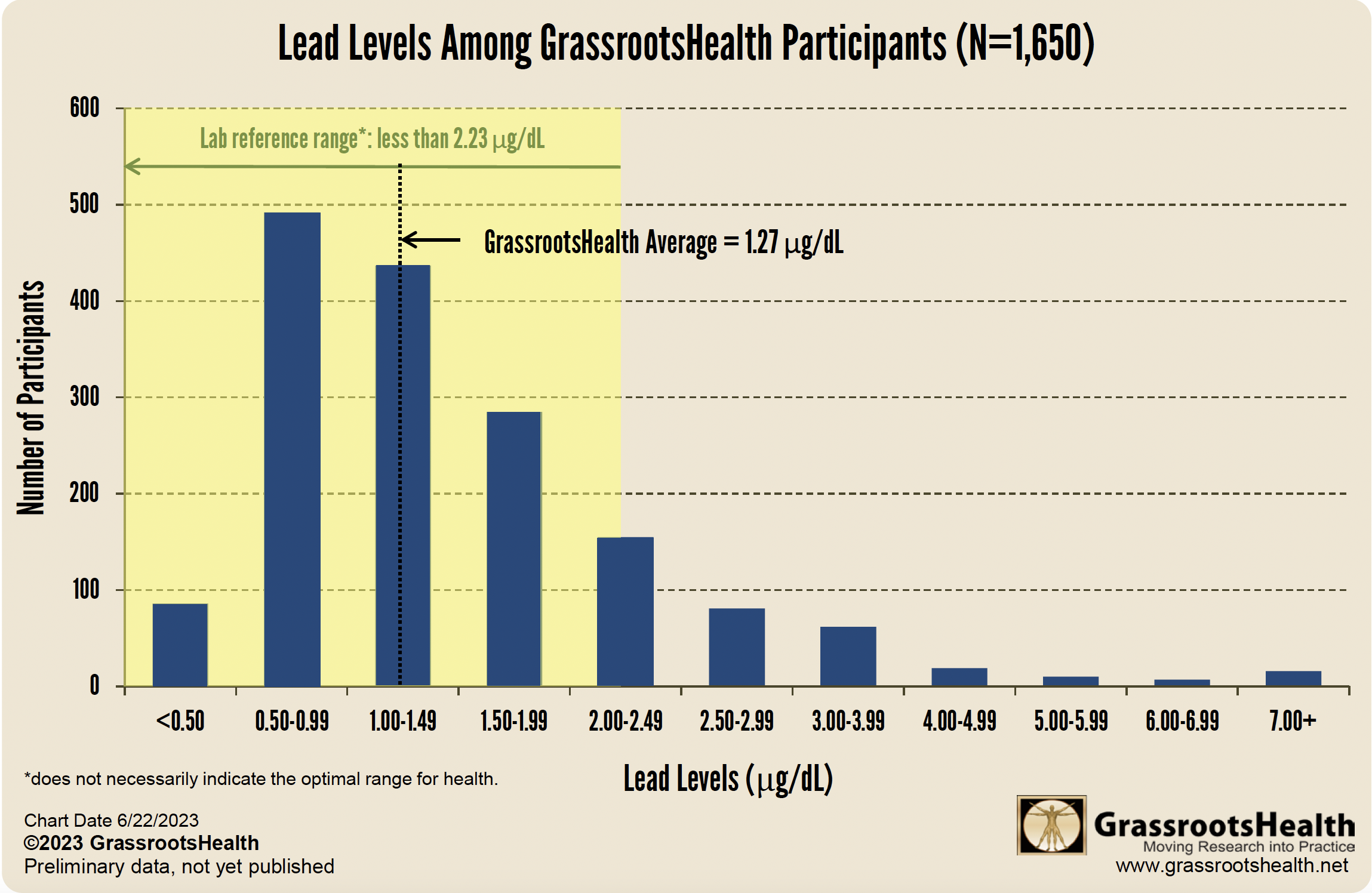Published on December 15, 2023
There is no safe level of lead, yet 65% of GrassrootsHealth participants have detectable levels; high levels of lead have been associated with neurological defects in developing children, low levels of vitamin D, and reduced hemoglobin synthesis… are you being affected by lead toxicity?
Key Points
- There is no safe level of lead in the body, yet approximately 65% of GrassrootsHealth participants had detectable levels of lead in their blood, with 16% having a result above the lab reference range cut-off; among participants who had completed at least two lead tests, nearly half (49%) lowered their lead levels after their first test
- Lead is poisonous and can lead to problems all over the body, especially within the brain, and it is especially harmful for children, babies, and pregnant women
- In the United States today, at least 4 million households with kids are exposed to high levels of lead, and nearly half a million children ages 1-5 have lead blood levels above 5 µg/dL; it is important to measure lead levels in the body and to know how lead exposure occurs in order to eliminate or minimize it
- Save 15% when including the Full Elements Panel in your test kit with code ELEMENTS15, now through 12/22/23
Add the Elements Panel to Your Home Test Kit Here
 Toxic elements, such as lead, cadmium, and mercury, have no known nutritional benefit and are known to interfere with proper functioning of proteins, lipids, and DNA within the cells. They can also interfere with essential elements by blocking their availability within the body. Toxins can contribute to the development of chronic diseases, making detoxification an important step towards healing and health, as briefly discussed by Dr. Richard Cheng in a recent post here.
Toxic elements, such as lead, cadmium, and mercury, have no known nutritional benefit and are known to interfere with proper functioning of proteins, lipids, and DNA within the cells. They can also interfere with essential elements by blocking their availability within the body. Toxins can contribute to the development of chronic diseases, making detoxification an important step towards healing and health, as briefly discussed by Dr. Richard Cheng in a recent post here.
The Full Elements panel offered by GrassrootsHealth measures the levels of essential elements magnesium, copper, selenium and zinc, as well as toxic elements lead, cadmium and mercury. Below is a summary of the latest analysis of lead levels among GrassrootsHealth participants, completed in June of 2023. Updated summaries of levels of cadmium and mercury among GrassrootsHealth participants will be covered in our next upcoming posts.
Any Level of Lead Could Harm Your Health
Lead is extremely poisonous and can lead to problems all over the body. It can accumulate over time and is stored in bone, blood, and tissues. Chronic, low-level lead exposure can affect the body’s cardiovascular, reproductive, and renal systems. Exposure can also reduce vitamin D and hemoglobin synthesis.
Short-term exposure to very high levels can cause abdominal pain, headaches, loss of appetite, weakness, and memory loss. During pregnancy, lead in bones can be released and passed from the mother’s body to the baby which may result in miscarriage, premature birth, low birth weight, learning or behavioral problems, or damage to the baby’s brain, kidneys, or nervous system.
Lead is particularly harmful to children because they absorb more lead than adults and their bodies are more vulnerable to its effects. In children, even low levels of lead in the blood can cause anemia, rashes, abdominal pain, loss of hearing, lower IQ, hyperactivity, and behavior and learning problems. Rarely, high levels of lead exposure in children can result in severe neurological defects, coma, or death. The video, What Does Lead Poisoning Do To Your Brain?, gives an excellent explanation of how lead can affect our health, with its most serious effects occurring in the brain.
Lead Exposure Remains an Issue in Many Areas
According to the CDC, in the United States today, at least 4 million households with kids are exposed to high levels of lead, and nearly half a million children ages 1-5 have lead blood levels above 5 µg/dL.
A study published by Hauptman et al. (September, 2021), evaluating lab data from 1,141,441 children ages 6 years or younger and living in all 50 US states and the District of Columbia, found that more than half of the children had detectable levels of lead (with a lead level of greater than 1 µg/dL), and 2% had levels of 5.0 μg/dL or more.
What are Lead Levels Among GrassrootsHealth Participants?
Among the 1,650 participants who had tested their lead levels, the average level was 1.27 μg/dL, which is higher than the average from our last analysis, done in June of 2020, of 1.24 μg/dL. A majority had levels within the lab reference range (less than 2.23 μg/dL); this reference range indicates the range of typical results found in the population the lab serves but does not necessarily indicate the optimal range for health.
While there is no safe level of lead in the body, 65% of GrassrootsHealth participants had detectable levels of lead in their blood (with a result of 1 ug/dL or higher). Approximately 16% of the participants who tested had levels above the lab reference range cut-off (greater than 2.23 μg/dL); the reference range indicates the range of typical results found in the population the lab serves but does not necessarily indicate the optimal range for health.
According to the Centers for Disease Control and Prevention (CDC), 5 µg/dL is considered the case classification of an elevated blood lead level, which is especially dangerous to pregnant women and children. Looking at lead levels among GrassrootsHealth participants, and considering only the latest result for those who have tested more than once, 33 participants had a level of 5 µg/dL or higher.
Additionally, 276 participants had completed at least two lead tests. Among these participants, nearly half (49%) lowered their lead levels after their first test.
Are You Being Exposed to Lead?
Lead is a metal from the earth’s crust that can be found in small amounts in the soil, water, and air. It has been used in numerous products such as paint, pipes, gasoline, batteries, cosmetics, jewelry, and ammunition. Lead can enter the environment from these sources or from current and former industrial facilities, especially those involved in mining or producing lead. With the discontinuation of lead-based paint and leaded gasoline in most countries, exposure to the general public has significantly declined.
Exposure to lead may occur by drinking water or eating food that contains lead. Using dishes or glasses that contain lead may also cause lead to be ingested. Lead can be inhaled, which is more readily absorbed by the body than when ingested. A common route for lead inhalation is during house construction projects in older homes if paint is disturbed or in buildings where lead-based paint is deteriorating. Additionally, working or participating in hobbies where lead is used, such as construction, lead glass making, soldering, or scrap metal recycling increase the risk of exposure. Children may have increased exposure because they are more likely to put their hands, toys, and dirt in their mouths. Multiple government agencies, such as the Environmental Protection Agency (EPA) and the Food and Drug Administration (FDA) develop and enforce regulations regarding lead in drinking water and consumer products. It is important to only buy and use regulated products.
Make sure you are not being over exposed to the toxic elements mercury, cadmium and lead, and that you are getting enough protective minerals magnesium, selenium, copper and zinc! Measure your levels of each by adding the Elements Panel to your next GrassrootsHealth home test kit.
Add the Elements Panel to Your Home Test Kit Here
(Save 15% with code ELEMENTS15 now through 12/22/23)
Need help eliminating some of these toxic metals? Learn more about Heavy Metals and the Power of Detoxification.
Test Your Lead Level as Part of the Elements Panel
 Measuring your level of lead and other toxic elements can help determine if you and your loved ones are being exposed, and if steps need to be taken to decrease that exposure and build-up in the body. Decreasing toxic elements while having and maintaining healthy levels of essential elements, vitamin D, and other nutrients can help improve your health now and for your future. Choose which to measure, such as your vitamin D, omega-3s, and essential and toxic minerals including magnesium and iron, by creating your custom home test kit today. Take steps to improve the status of each of these measurements to benefit your overall health. You can also track your own intakes, symptoms and results to see what works best for YOU.
Measuring your level of lead and other toxic elements can help determine if you and your loved ones are being exposed, and if steps need to be taken to decrease that exposure and build-up in the body. Decreasing toxic elements while having and maintaining healthy levels of essential elements, vitamin D, and other nutrients can help improve your health now and for your future. Choose which to measure, such as your vitamin D, omega-3s, and essential and toxic minerals including magnesium and iron, by creating your custom home test kit today. Take steps to improve the status of each of these measurements to benefit your overall health. You can also track your own intakes, symptoms and results to see what works best for YOU.
Enroll and test your levels today, learn what steps to take to improve your status of vitamin D (see below) and other nutrients and blood markers, and take action! By enrolling in the GrassrootsHealth projects, you are not only contributing valuable information to everyone, you are also gaining knowledge about how you could improve your own health through measuring and tracking your nutrient status, and educating yourself on how to improve it.






